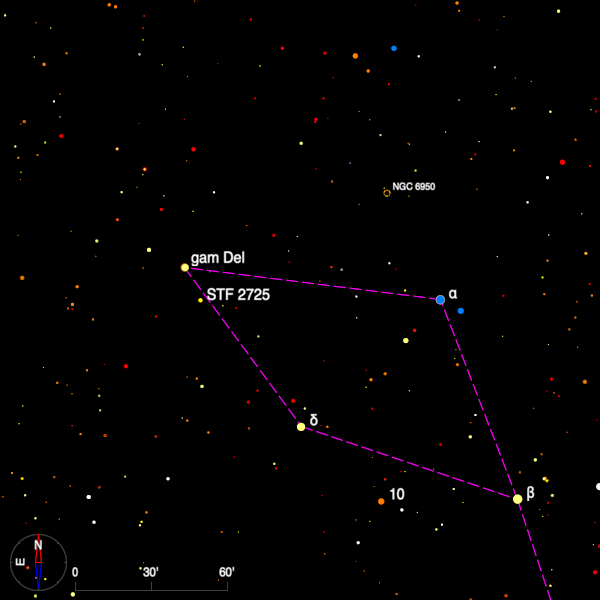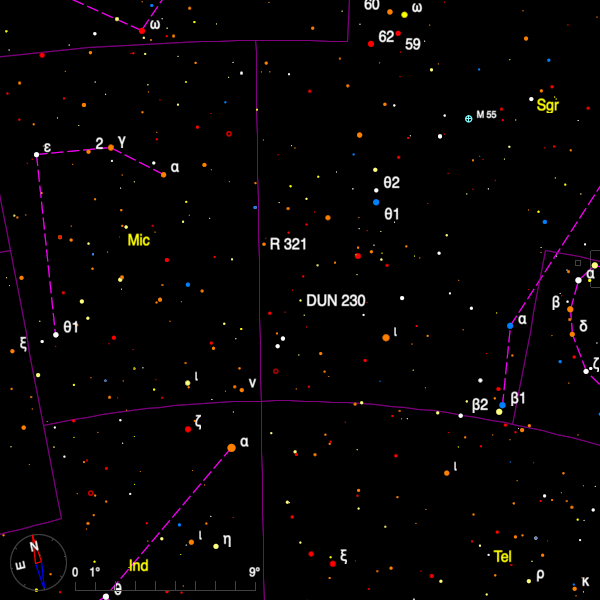Double Star of the Month in Delphinus
-
September 2022 - Double Star of the Month
I noted, rather surprisingly, that this column had yet to deal with gamma Delphini (20 46 39.50 +16 07 27.5) so this is a good opportunity to do so. One of the finest pairs in the sky because of its glorious colours, gamma has been known since the time of James Bradley (1755).

A finder chart for the double stars gamma Delphini and STF 2725 created with Cartes du Ciel. The stars are magnitudes 4.4 and 5.0 and they are currently 8".8 apart in position angle 264 degrees. Although there has been little motion between the two since Bradley's time, an orbit with a period of 3249 years has been calculated which predicts a closest approach of 0".8 in around 2300. The apparent orbit as plotted in the USNO 6th orbital catalogue shows little, if any, sign of orbital curvature but the stars have the same parallax, if only just.
The results of radial velocity observations of both stars with the intention of finding exoplanets have not confirmed any.
Smyth observed the pair on many occasions and found colours of yellow and light emerald, whilst I made them golden yellow and blue-green when I first observed them during a youthful survey of double stars in 1968. Thirty arc-minutes south preceding gamma is the pair STF 2725, also a long-period binary. It has stars of magnitude 7.5 and 8.2 at 12 degrees and 6".2.
Right on the border between Sagittarius and Microscopium, R 321 (20 26 52.95 -37 24 10.5) is a fine binary which is well worth sweeping for.

A finder chart for the double stars R 321 and DUN 230 created with Cartes du Ciel. Found by H. C. Russell at Sydney Observatory, this pair has a period of 186.4 years and the motion of the stars is in decreasing position angle (retrograde). In 1880, when first observed, the stars according to Russell were 1".1 apart , then by 1950 they had closed up to 0".26 before later opening out. At the present time they are 1".6 apart, with widest separation occurring around 2029. The stars have visual magnitudes of 6.2 and 7.9 and are orange in hue - each is an early-K dwarf. They should be comfortably divided with 10 or 12-cm.
Whilst in the area, move about 3 degrees SSW, and you will find DUN 230 (20 17 49.68 -40 11 05.1) which is an easy object for the smallest aperture. The two components are both of late-F spectral type and whose visual magnitudes are 7.4 and 7.7; the stars are 9".7 apart in PA 117 degrees, and lie 257 light-years away.
Bob Argyle - Double Star Section Director
-
September 2018 - Double Star of the Month
STF 2735 (20 55 40.64 +04 31 57.70) is a pretty pair discovered by William Herschel in 1782. It is 1 degree WNW of 1 Equulei which is a bright triple, although the primary pair is now beyond all but the ground-based arrays.
F. G. W. Struve noted the stars were yellow and ash, whilst Smyth in the Bedford Catalogue noted orange tint and purple. More recently John Nanson on the Star-Splitters blog, using a 5-inch f/15 refractor at x191 thought the primary was
white with a weak but noticeable gold-yellow tinge
.The stars form a very long period binary and have moved only 8 degrees in almost 200 years. Gaia DR2 puts them at a distance of 351 light-years. Webb noted that the stars were magnitudes 6.2 and 7.5 but the Washington Double Star Catalog (WDS) reduces the difference in magnitude to 1.0. John Nanson suspected that they were more unequal than that and indeed Gaia DR2 gives G magnitudes (similar to V) of 6.1 and 7.4. Using the Cambridge 8-inch refractor the writer found 283.6 degrees and 2".21 in 2011.
Three degrees west of the nearby dwarf Epsilon Indi is a coarse binocular triple which seems to have evaded Dunlop and been first pointed out by W. S. Jacob and which sits in the WDS catalogue as JC 25 (21 43 59.16 -57 19 30.4).
The two brightest stars sit 152" apart in PA 4 degrees and have both very similar and quite significant annual proper motions (115 mas in RA, -53 mas in Dec) and parallaxes (22.54 mas and 22.49 mas, respectively for A and B) such that they are almost certainly physical. The third star, C, is 187" away in PA 214, is magnitude 7.5 and is unconnected. Gaia DR2 puts it 600 light-years away.
Bob Argyle - Double Star Section Director
-
August 2016 - Double Star of the Month
STF 2690 (20 31 11.94 +11 15 37.7) was found by William Herschel in 1779 and he called it H III 16. Since that time the position angle has reduced 26° to 255° and the separation has increased from 15" to 17".6.
Located in Delphinus it can be found just 30 arc mins preceding epsilon Del. Also in a low power field is 1 Del (BU 63) an unequal close pair which is a test for 15-cm.
The components of STF 2690 are mags 7.1 and 7.4 and Sissy Haas called them both 'peach-white'. Whilst observing at George Bishop's observatory, at South Villa in Regent's Park, London, W. R. Dawes noted
.. on the first night on which I measured this object with Mr. BISHOP's 7-inch refractor (1840, Oct 27) I perceived that B was unquestionably wedge-shaped, and succeeded in obtaining moderately good measures of it
. Dawes also speculated on why Struve has missed this pair during the Dorpat survey, and suggested that pairs such as STF 2690, being wide and easy, were only measured on poor nights and hence the real nature of star B would have eluded him.DA 1, as the close pair became known, has a highly eccentric orbit and the separation ranges from 0".55 to 0".02, a distance which it attained in the last years of the previous century. It is now widening and in mid-2016, the separation is expected to be 0".34. The stars are mags 7.9 and 8.0 so this will be a severe test for 30-cm. A is also a very close pair being found in speckle survey of B stars in 1983. Motion appears slow and the period is likely to be a century or more.
Rho Capricorni (SHJ 323 - 20 28 52.19 -17 48 49.2) is the northernmost of a bright triangle of naked-eye stars about 5 degrees south-south-east of beta Capricorni. Of the other two, omicron featured in this column in 2015, and pi will appear in 2017.
Although discovered by the elder Herschel the pair now has the moniker SHJ attached to it - the name for stars catalogued by James South and Sir John Herschel.
This is a binary of period 278 years which is now widening but will remain quite a difficult object for the northern observer. The writer has not yet observed it but with a magnitude difference of 2 between the brightest components and a separation of 1".8 then it requires a good night to be seen.
There is a 13.3 star at 55" (distance increasing) and a 6.7 mag star some 259" away (and increasing) has, in turn, a companion of mag 10.6 at 54" and is catalogued as DOB 13DE.
Sissy Haas notes that A and D are pretty -
Bright Sun-yellow and pale rose-red
.Bob Argyle - Double Star Section Director